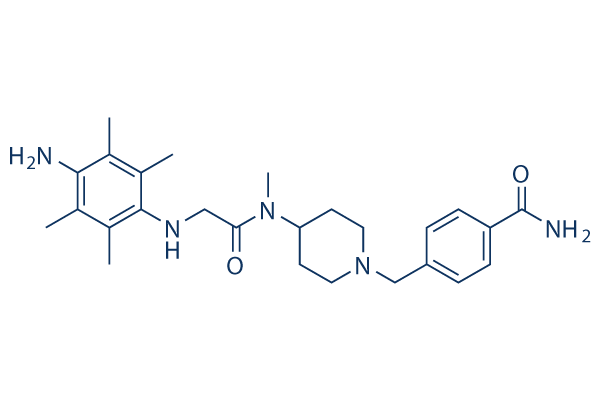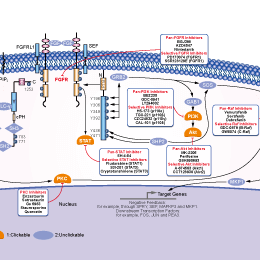
- Bioactive Compounds
- By Signaling Pathways
- PI3K/Akt/mTOR
- Epigenetics
- Methylation
- Immunology & Inflammation
- Protein Tyrosine Kinase
- Angiogenesis
- Apoptosis
- Autophagy
- ER stress & UPR
- JAK/STAT
- MAPK
- Cytoskeletal Signaling
- Cell Cycle
- TGF-beta/Smad
- DNA Damage/DNA Repair
- Compound Libraries
- Popular Compound Libraries
- Customize Library
- Clinical and FDA-approved Related
- Bioactive Compound Libraries
- Inhibitor Related
- Natural Product Related
- Metabolism Related
- Cell Death Related
- By Signaling Pathway
- By Disease
- Anti-infection and Antiviral Related
- Neuronal and Immunology Related
- Fragment and Covalent Related
- FDA-approved Drug Library
- FDA-approved & Passed Phase I Drug Library
- Preclinical/Clinical Compound Library
- Bioactive Compound Library-I
- Bioactive Compound Library-Ⅱ
- Kinase Inhibitor Library
- Express-Pick Library
- Natural Product Library
- Human Endogenous Metabolite Compound Library
- Alkaloid Compound LibraryNew
- Angiogenesis Related compound Library
- Anti-Aging Compound Library
- Anti-alzheimer Disease Compound Library
- Antibiotics compound Library
- Anti-cancer Compound Library
- Anti-cancer Compound Library-Ⅱ
- Anti-cancer Metabolism Compound Library
- Anti-Cardiovascular Disease Compound Library
- Anti-diabetic Compound Library
- Anti-infection Compound Library
- Antioxidant Compound Library
- Anti-parasitic Compound Library
- Antiviral Compound Library
- Apoptosis Compound Library
- Autophagy Compound Library
- Calcium Channel Blocker LibraryNew
- Cambridge Cancer Compound Library
- Carbohydrate Metabolism Compound LibraryNew
- Cell Cycle compound library
- CNS-Penetrant Compound Library
- Covalent Inhibitor Library
- Cytokine Inhibitor LibraryNew
- Cytoskeletal Signaling Pathway Compound Library
- DNA Damage/DNA Repair compound Library
- Drug-like Compound Library
- Endoplasmic Reticulum Stress Compound Library
- Epigenetics Compound Library
- Exosome Secretion Related Compound LibraryNew
- FDA-approved Anticancer Drug LibraryNew
- Ferroptosis Compound Library
- Flavonoid Compound Library
- Fragment Library
- Glutamine Metabolism Compound Library
- Glycolysis Compound Library
- GPCR Compound Library
- Gut Microbial Metabolite Library
- HIF-1 Signaling Pathway Compound Library
- Highly Selective Inhibitor Library
- Histone modification compound library
- HTS Library for Drug Discovery
- Human Hormone Related Compound LibraryNew
- Human Transcription Factor Compound LibraryNew
- Immunology/Inflammation Compound Library
- Inhibitor Library
- Ion Channel Ligand Library
- JAK/STAT compound library
- Lipid Metabolism Compound LibraryNew
- Macrocyclic Compound Library
- MAPK Inhibitor Library
- Medicine Food Homology Compound Library
- Metabolism Compound Library
- Methylation Compound Library
- Mouse Metabolite Compound LibraryNew
- Natural Organic Compound Library
- Neuronal Signaling Compound Library
- NF-κB Signaling Compound Library
- Nucleoside Analogue Library
- Obesity Compound Library
- Oxidative Stress Compound LibraryNew
- Plant Extract Library
- Phenotypic Screening Library
- PI3K/Akt Inhibitor Library
- Protease Inhibitor Library
- Protein-protein Interaction Inhibitor Library
- Pyroptosis Compound Library
- Small Molecule Immuno-Oncology Compound Library
- Mitochondria-Targeted Compound LibraryNew
- Stem Cell Differentiation Compound LibraryNew
- Stem Cell Signaling Compound Library
- Natural Phenol Compound LibraryNew
- Natural Terpenoid Compound LibraryNew
- TGF-beta/Smad compound library
- Traditional Chinese Medicine Library
- Tyrosine Kinase Inhibitor Library
- Ubiquitination Compound Library
-
Cherry Picking
You can personalize your library with chemicals from within Selleck's inventory. Build the right library for your research endeavors by choosing from compounds in all of our available libraries.
Please contact us at [email protected] to customize your library.
You could select:
- Antibodies
- Bioreagents
- qPCR
- 2x SYBR Green qPCR Master Mix
- 2x SYBR Green qPCR Master Mix(Low ROX)
- 2x SYBR Green qPCR Master Mix(High ROX)
- Protein Assay
- Protein A/G Magnetic Beads for IP
- Anti-Flag magnetic beads
- Anti-Flag Affinity Gel
- Anti-Myc magnetic beads
- Anti-HA magnetic beads
- Magnetic Separator
- Poly DYKDDDDK Tag Peptide lyophilized powder
- Protease Inhibitor Cocktail
- Protease Inhibitor Cocktail (EDTA-Free, 100X in DMSO)
- Phosphatase Inhibitor Cocktail (2 Tubes, 100X)
- Cell Biology
- Cell Counting Kit-8 (CCK-8)
- Animal Experiment
- Mouse Direct PCR Kit (For Genotyping)
- New Products
- Contact Us
SUN11602
SUN11602 is a small synthetic compound that mimics the neuroprotective activities of bFGF and activates key molecules in the FGF receptor-1-mitogen-activated protein kinase/extracellular signal-regulated kinase-1/2 kinase (FGFR-1-MEK/ERK) signaling pathway.

SUN11602 Chemical Structure
CAS No. 704869-38-5
Purity & Quality Control
Batch:
S819201
DMSO]90 mg/mL]false]Ethanol]31 mg/mL]false]Water]Insoluble]false
Purity:
99.01%
99.01
SUN11602 Related Products
| Related Targets | FGFR1 FGFR2 FGFR3 FGFR4 | Click to Expand |
|---|---|---|
| Related Products | Fexagratinib (AZD4547) PD173074 BLU9931 LY2874455 Zoligratinib (Debio-1347) Futibatinib (TAS-120) PD-166866 SSR128129E H3B-6527 Fisogatinib (BLU-554) Derazantinib FIIN-2 Ferulic Acid ASP5878 Roblitinib (FGF401) Alofanib (RPT835) NSC12 PRN1371 | Click to Expand |
| Related Compound Libraries | Tyrosine Kinase Inhibitor Library PI3K/Akt Inhibitor Library Angiogenesis Related compound Library HIF-1 Signaling Pathway Compound Library FDA-approved Anticancer Drug Library | Click to Expand |
Signaling Pathway
Biological Activity
| Description | SUN11602 is a small synthetic compound that mimics the neuroprotective activities of bFGF and activates key molecules in the FGF receptor-1-mitogen-activated protein kinase/extracellular signal-regulated kinase-1/2 kinase (FGFR-1-MEK/ERK) signaling pathway. | |
|---|---|---|
| Targets |
|
| In vitro | ||||
| In vitro | Physiological actions of SUN11602 mimic several phenomena of the neuroprotection that is induced by bFGF. SUN11602 plays a pivotal role in allowing primary cultured neurons to survive in adverse environments of glutamate toxicity and activating intracellular key molecules that are involved in the neuroprotective mechanisms. These actions are quite similar to those of bFGF. Such neuroprotective mechanisms are specific and distinctive to SUN11602 and bFGF and differs clearly from those of the other growth factors that are investigated. But unlike bFGF, SUN11602 can either directly or indirectly trigger the phosphorylation of the cytosolic domain of the FGFR without binding to the extracellular domain of the FGFR-1[1]. SUN11602 demonstrates no cell proliferative activity of somatic cells, unlike bFGF. SUN11602 significantly affects neuronal survival in adverse conditions through a FGFR1-mitogen-activated protein kinase/extracellular signal-regulated kinase-1/2 kinase (FGFR-1–MEK/ERK) signaling pathway[2]. | |||
|---|---|---|---|---|
| Cell Research | Cell lines | Rat cerebrocortical neurons | ||
| Concentrations | 0.1, 0.3, 1 μM | |||
| Incubation Time | 24 h | |||
| Method | Actinomycin D or cycloheximide is first added to the cultures, and, 2 h later, SUN11602 or bFGF is added. After a 24 h incubation, neurons in the cultures are exposed to 150 μM glutamate for another 24 h, and cell viability is determined by a (3-(4,5-dimethyl-2-thiazolyl)-2,5-diphenyl-2H tetrazolium bromide (MTT) assay. | |||
| In Vivo | ||
| In vivo | In WT mice, SUN11602 and bFGF increase the levels of newly synthesized Calb in cerebrocortical neurons and suppress the glutamate-induced rise in intracellular Ca2+. This Ca2+-capturing ability of Calb allows the neurons to survive severe toxic conditions of glutamate. In contrast, Calb levels remain unchanged in Calb-/- mice after exposure to SUN11602 or bFGF, and due to a loss of function of the gene, these neurons are no longer resistant to toxic conditions of glutamate[1]. Neuroprotective activities of SUN11602 and FGF-2 are due to exogenously induced hyperexpression of CalB in hippocampal neurons. The pharmacokinetic properties of SUN11602 appear to hold promise in terms of bioavailability (>65%) after oral administration in rodents (rats and mice) and dogs (beagles)[2]. | |
|---|---|---|
| Animal Research | Animal Models | A rat model of hippocampal tissue damage |
| Dosages | 0.3, 1 and 3 mg/kg | |
| Administration | oral administration | |
Chemical Information & Solubility
| Molecular Weight | 451.60 | Formula | C26H37N5O2 |
| CAS No. | 704869-38-5 | SDF | Download SUN11602 SDF |
| Smiles | CC1=C(C(=C(C(=C1N)C)C)NCC(=O)N(C)C2CCN(CC2)CC3=CC=C(C=C3)C(=O)N)C | ||
| Storage (From the date of receipt) | |||
|
In vitro |
DMSO : 90 mg/mL ( (199.29 mM) Moisture-absorbing DMSO reduces solubility. Please use fresh DMSO.) Ethanol : 31 mg/mL Water : Insoluble |
Molecular Weight Calculator |
|
In vivo Add solvents to the product individually and in order. |
In vivo Formulation Calculator |
||||
Preparing Stock Solutions
Molarity Calculator
In vivo Formulation Calculator (Clear solution)
Step 1: Enter information below (Recommended: An additional animal making an allowance for loss during the experiment)
mg/kg
g
μL
Step 2: Enter the in vivo formulation (This is only the calculator, not formulation. Please contact us first if there is no in vivo formulation at the solubility Section.)
% DMSO
%
% Tween 80
% ddH2O
%DMSO
%
Calculation results:
Working concentration: mg/ml;
Method for preparing DMSO master liquid: mg drug pre-dissolved in μL DMSO ( Master liquid concentration mg/mL, Please contact us first if the concentration exceeds the DMSO solubility of the batch of drug. )
Method for preparing in vivo formulation: Take μL DMSO master liquid, next addμL PEG300, mix and clarify, next addμL Tween 80, mix and clarify, next add μL ddH2O, mix and clarify.
Method for preparing in vivo formulation: Take μL DMSO master liquid, next add μL Corn oil, mix and clarify.
Note: 1. Please make sure the liquid is clear before adding the next solvent.
2. Be sure to add the solvent(s) in order. You must ensure that the solution obtained, in the previous addition, is a clear solution before proceeding to add the next solvent. Physical methods such
as vortex, ultrasound or hot water bath can be used to aid dissolving.
Tech Support
Answers to questions you may have can be found in the inhibitor handling instructions. Topics include how to prepare stock solutions, how to store inhibitors, and issues that need special attention for cell-based assays and animal experiments.
Tel: +1-832-582-8158 Ext:3
If you have any other enquiries, please leave a message.
* Indicates a Required Field
Tags: buy SUN11602 | SUN11602 supplier | purchase SUN11602 | SUN11602 cost | SUN11602 manufacturer | order SUN11602 | SUN11602 distributor







































